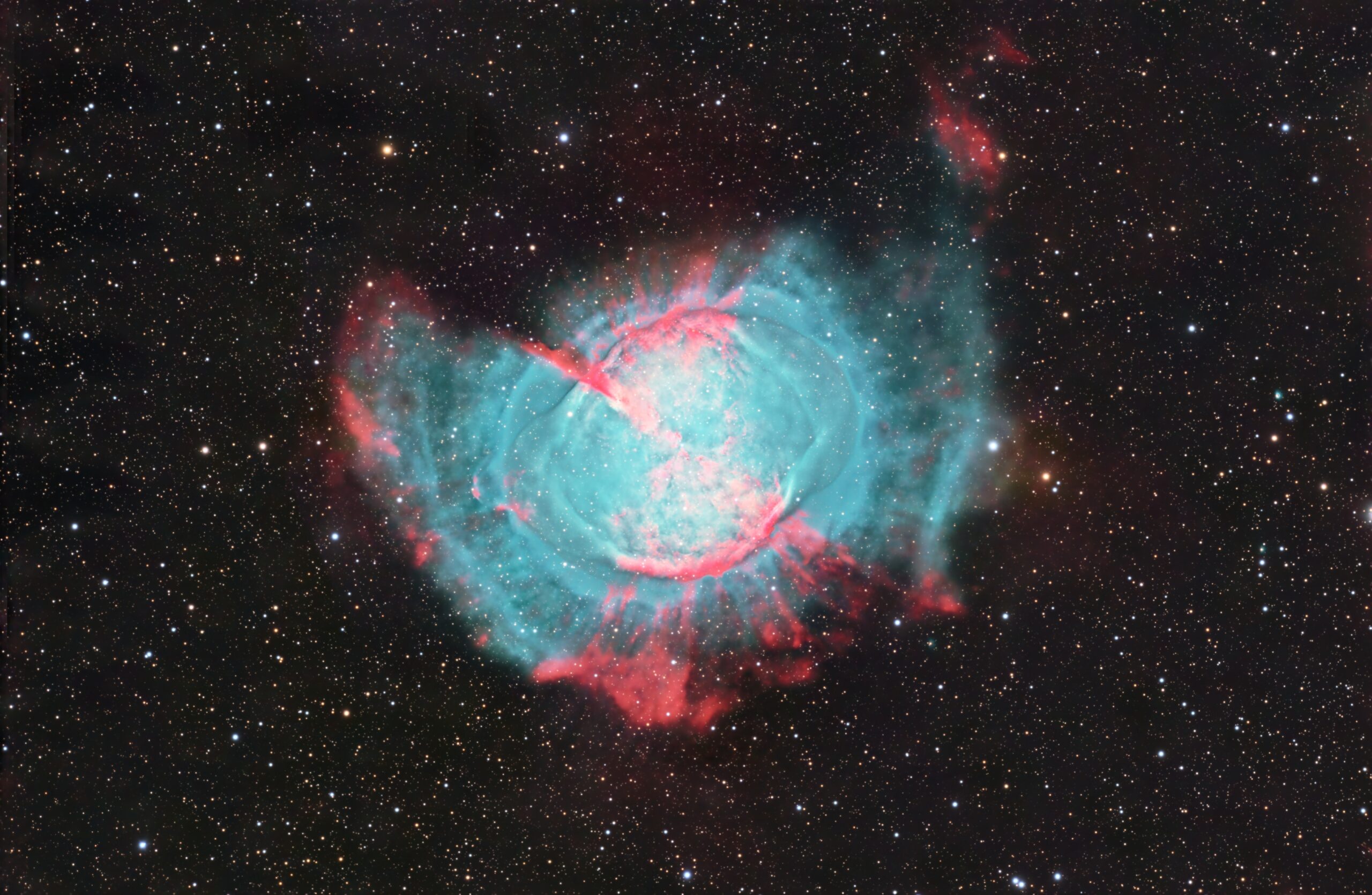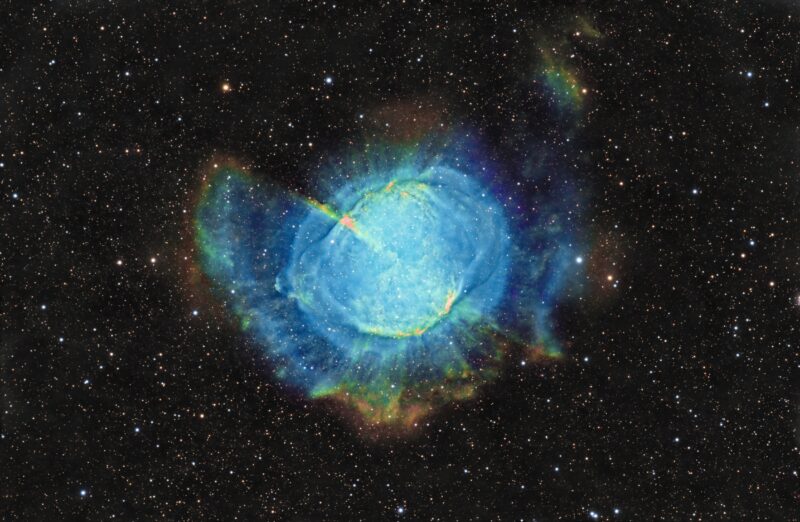Messier 27 in Three Palettes
Click an image for full size version
August 18, 2024
M27 is a classic example of a “planetary nebula,” so named because they looked similar to planets to early observers. M27 is known as the Dumbbell Nebula because of its visual appearance through a telescope. It is found in the constellation Vulpecula (“the Little Fox”), which is well placed for observing shortly after dark at this time of year. The nebula’s colours in this image are due to gas thrown off by the dying star at its centre. This white dwarf emits radiation that causes the gas to glow in visible light. Hydrogen emits mostly red and oxygen mostly green-blue light. Like all planetary nebulae, the Dumbbell will gradually expand and dissipate, becoming fainter over time. I guess we’re lucky to be here at this particular time in history and able to see it. The dumbbell is about 1360 light years away, and is 10,000-15,000 years old.
I have shot this object several times with different equipment. The 2014 image was published several times, including Astronomy Magazine Picture of the Day on May 19, 2017. I also imaged it in 2016, and that version ended up being my first cover of Sky & Telescope magazine. The current version shows more detail by far than any of my previous attempts. In addition to a natural colour version dominated by red and teal, I prepared two narrowband false colour versions with natural-colour stars: Hubble palette and Foraxx palette.
Tekkies:
Acquisition, focusing, and control of Paramount MX mount with N.I.N.A., TheSkyX and PHD2. Primalucelab low=profile 2″ Essato focuser and ARCO rotator. Equipment control with PrimaLuce Labs Eagle 4 Pro computer. All pre-processing and processing in PixInsight. Acquired from my SkyShed in Guelph. Average transparency and seeing. Data acquired under little to no moonlight between July 15 – 29, 2024.
Celestron 14″ EDGE HD telescope at f/11 (3,931 mm focal length) and QHY600M camera binned 2×2 with Optolong filters.
49x5m Red = 4hr05m
47x5m Green = 3hr55m
48x5m Blue = 4hr00m
117x5m Ha = 9hr45m
116x5m O3 = 9hr40m
123x5m S2 = 10hr15m
Total: 41hr40m
Preprocessing: The WeightedBatchPreProcessing script was used to perform calibration, cosmetic correction, weighting, registration, local normalization, integration, drizzle integration and auto-cropping.
Colour master: A colour master was made from the Red, Green and Blue masters using ChannelCombination in RGB mode.
Gradient Removal: DynamicBackgroundExtraction was applied to the RGB and narrowband masters.
Colour Calibration: ColorCalibration was used to calibrate the RGB master.
Deconvolution: BlurXterminator was used on the RGB and narrowband masters with Automatic psf at default settings.
Linear Noise Reduction: NoiseXterminator was applied to the RGB and narrowband masters with settings Amount=0.9 and Detail=0.35
Star Removal: StarXterminator was used to remove the stars from each of the RGB and narrowband masters, with default settings. Only the RGB stars-only image was preserved.
Hubble Palette Image Creation: The S, H and O masters were balanced to H using LinearFit and combined using ChannelCombination in RGB mode.
Stretching: HistogramTransformation was applied to the RGB, SHO and narrowband masters, each in two steps, to make pleasing images. In the first application, the core was stretched. A second stretch was applied to background and faint nebula regions using a mask to protect the core. Approximate background level after the stretches was 0.10 for RGB and SHO and 0.08 for the individual narrowband masters.
Nonlinear Processing
HOSRGB Image Creation: An HORGB image was made using the NBRGBCombination script. This was followed by PixelMath to blend S into the HORGB image using the following expression with parameter values a=1.2 and b=0.06.
Red: max($T[0], a*S)
Green: $T[1]
Blue: $T[2]
Foraxx Palette Image Creation: The stretched S, H and O masters were combined with Paul Hancock’s Foraxx Palette Utility script.
Background Cleanup: Artifacts that were visible in the three master images due to the extreme stretching were removed using the CloneStamp tool
Nonlinear Noise Reduction: NoiseXterminator was used to reduce noise in the background areas of the HOSRGB, SHO and Forrax images with settings Amount=0.9 and Detail=0.15
Dynamic Range Compression: The CreateHDRImage script was used to compress the core of the nebula using a mask made with the RangeSelection tool.
Contrast Enhancement: LocalHistogramEqualization was applied twice to each image using a mask to protect the background. A Contrast Limit of 1.5 and 1 iteration was used for each LHE application (scale 40, strength 0.35; scale 150, strength 0.18).
Brightness Enhancement: Using a mask to protect the background and bright parts of the nebula, the faint parts of the nebula were brightened in each master image with ExponentialTransformation and CurvesTransformation.
Sharpening: A mask was used to select brighter regions of nebulosity in each image for sharpening with MultiscaleMedianTransform (Layers 1 – 4 with strengths of 0.01, 0.07, 0.07, and 0.03, respectively).
Hubble Palette and Foraxx Colour Adjustments: CurvesTransformation was used with the Hue tool to adjust the colour tones in the two narrowband images.
Star Processing and Restoration: HistogramTransformation was used to stretch the stars-only RGB image, followed by CurvesTransformation through a star mask to boost saturation using the Saturation and CIE c* sliders. The stars were added back into the HOSRGB, SHO and Foraxx master images using the Screen blending mode in PixelMath using the expression combine(starless, stars, op_screen()).
Final Steps: Background, nebula and star brightness, contrast and saturation were adjusted using several iterations of CurvesTransformation, with masks, as required. ICCProfileTransformation (sRGB IEC61966-2.1; Relative Colorimetric with black point compensation) was applied prior to saving as a jpg. The finder chart was made using the FindingChart process.










Fantastic work on this object.